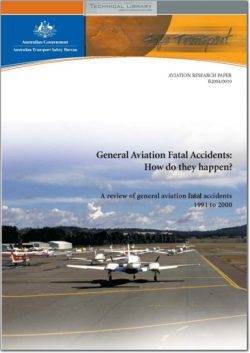ATSB-B2004-0010

- Version
- 164 Downloads
- 1.62 MB File Size
- 1 File Count
- August 9, 2016 Create Date
- August 9, 2016 Last Updated
General Aviation Fatal Accidents; How do they happen - A review of General Aviation Fatal Accidents 1991 to 2000

Australian aviation is, by world standards, extremely safe. Fatal accidents in regular public
transport (RPT) operations are low and, since the late 1960s, have been confined to low capacity
operations. Australia has not had a high capacity RPT fatal accident since 1968 and has not had
a RPT jet fatal accident.
The vast majority of Australian civil fatal aircraft accidents occur in general aviation (GA)
operations.This study examined Australian ‘VH-registered’ civil aircraft involved in GA fatal
accidents for the period 1991 to 2000, and covers fatal accident numbers and rates by aircraft
type and operational grouping, timing of accidents, injury levels, pilot demographics and fatal
accident types.
Between 1991 and 2000 inclusive, there were 215 fatal accidents and 413 associated fatalities.
Over the ten—year period there were 1.2 GA fatal accidents per 100,000 hours flown. The annual
fatal accident rate decreased fiom 1.6 fatal accidents per 100,000 hours flown in 1991 to 0.9 in
2000. While this decrease was not datistically significant, subsequent data to the end of 2002 do
indicate a statistically significant decrease. Statiaically significant variations were identified at
certain times ofthe day and week, indicatingthat occurrences were more likely to be fatal
accidents at certain times. The rate ofgeneral aviation fatal accidents was foundto be
significantly higher during the evening between 1700 and 2059than the rest ofthe day andthe
private/business fatal accident rate was foundto be significantly higher over the weekendthan
during the week. Reasons forthese findings could not be clearly identified.
The population of pilots involved in fatal accidents was compared with the present population of
active general aviation pilots against certain demographic criteria.
The risk of a fatal accident per hour flown was greater for pilots who had between 50 and 1,000
hours aeronautical experience than pilots who had more than 1,000 hours experience. However,
with the low number of pilots involved in fatal accidents, small changes in the demographics of
pilots involved in fatal accidents can lead to large changes in the risk associated with different
age and experience groupings.
| File | Action |
|---|---|
| ATSB-B2004-0010 General Aviation Fatal Accidents; How do they happen - A review of General Aviation Fatal Accidents 1991 to 2000.pdf | Download |

Comment On This Post